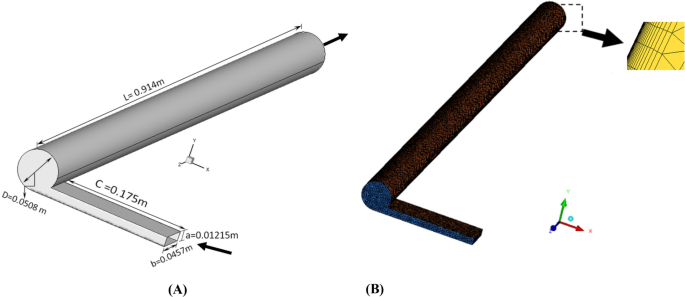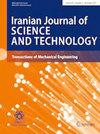Effects of Circumferential and Longitudinal Ribs and Grooves in Swirl Cooling on Characteristics of Pressure Drop and Heat Transfer
IF 1.7
4区 工程技术
Q3 ENGINEERING, MECHANICAL
Iranian Journal of Science and Technology-Transactions of Mechanical Engineering
Pub Date : 2023-09-14
DOI:10.1007/s40997-023-00707-0
引用次数: 0
Abstract
Abstract The impact of roughened swirl cooling chamber walls on heat transfer and fluid flow characteristics is explored in this study. This study compares ten roughened wall shapes against a smooth wall in a swirl cooling chamber. The roughened wall shapes are circumferential and longitudinal with and without cuts. The circumferential cases consist of four cases. The first case, designated as a circumferential groove (CG), contains eight grooves along the surface. The second case, designated as a circumferential groove cut (CGC), has eight cut grooves along the surface. The third case is called a circumferential rib (CR), and the fourth case is called a circumferential rib cut (CRC), and it has eight ribs without and with surface cuts. While the longitudinal cases consist of six cases. The first four cases, which have six longitudinal grooves and ribs with and without cuts, are longitudinal groove (LG), longitudinal groove cut (LGC), longitudinal rib (LR), and longitudinal rib cut (LRGC). The final two longitudinal cases, longitudinal rib groove (LRG) and Longitudinal rib and groove cut (LRGC), have hybrid grooves and ribs without and with surface cuts. Bulk temperature averaged circumferential heat transfer ratio, friction factor, global thermal performance factor, and turbulent kinetic energy are among the variables that were examined. Simulations are performed using CFD codes. These examined parameters are contrasted with results from previous studies. The findings demonstrate that heat transfer is boosted by roughly 2.7, 2.6, and 2.5 times higher in cases with LG, CG, and CGC, respectively, than in the smooth case. The use of rough walls in the swirl cooling chamber boosts the global thermal performance factor; the LG case has a 2.8 times higher global thermal performance factor than a smooth case. In comparison with alternative internal cooling technologies, a grooved wall, as shown in the LG case, has the best heat transfer characteristics.

旋流冷却中周向和纵向肋槽对压降和传热特性的影响
摘要本研究探讨了粗糙化涡流冷却室壁面对传热和流体流动特性的影响。这项研究比较了十种粗糙的壁面形状和一个光滑的壁面在一个漩涡冷却室。粗糙的壁形是圆周和纵向的,有和没有切割。圆周情况包括四种情况。第一种情况,被指定为圆周槽(CG),沿表面包含八个槽。第二种情况,指定为圆周槽切割(CGC),沿表面有八个切割槽。第三种情况被称为圆周肋骨(CR),第四种情况被称为圆周肋骨切割(CRC),它有八根肋骨,没有和表面切割。而纵向病例由六个病例组成。前4例有6个纵槽和肋骨,有和没有切口,分别是纵槽(LG)、纵槽切割(LGC)、纵肋(LR)和纵肋切割(LRGC)。最后两种纵向情况,纵向肋槽(LRG)和纵向肋槽切割(LRGC),有混合凹槽和肋,无表面切割和有表面切割。体温平均周向换热比、摩擦系数、整体热性能系数和湍流动能是研究的变量之一。利用CFD代码进行了仿真。这些检查参数与以前的研究结果进行了对比。研究结果表明,与光滑的情况相比,LG、CG和CGC的传热分别提高了大约2.7倍、2.6倍和2.5倍。在涡流冷却室中使用粗糙壁提高了整体热性能系数;LG外壳的整体热性能系数比光滑外壳高2.8倍。与其他内部冷却技术相比,如LG案例所示,沟槽壁具有最佳的传热特性。
本文章由计算机程序翻译,如有差异,请以英文原文为准。
求助全文
约1分钟内获得全文
求助全文
来源期刊

Iranian Journal of Science and Technology-Transactions of Mechanical Engineering
ENGINEERING, MECHANICAL-
CiteScore
2.90
自引率
7.70%
发文量
76
审稿时长
>12 weeks
期刊介绍:
Transactions of Mechanical Engineering is to foster the growth of scientific research in all branches of mechanical engineering and its related grounds and to provide a medium by means of which the fruits of these researches may be brought to the attentionof the world’s scientific communities. The journal has the focus on the frontier topics in the theoretical, mathematical, numerical, experimental and scientific developments in mechanical engineering as well
as applications of established techniques to new domains in various mechanical engineering disciplines such as: Solid Mechanics, Kinematics, Dynamics Vibration and Control, Fluids Mechanics, Thermodynamics and Heat Transfer, Energy and Environment, Computational Mechanics, Bio Micro and Nano Mechanics and Design and Materials Engineering & Manufacturing.
The editors will welcome papers from all professors and researchers from universities, research centers,
organizations, companies and industries from all over the world in the hope that this will advance the scientific standards of the journal and provide a channel of communication between Iranian Scholars and their colleague in other parts of the world.
 求助内容:
求助内容: 应助结果提醒方式:
应助结果提醒方式:


